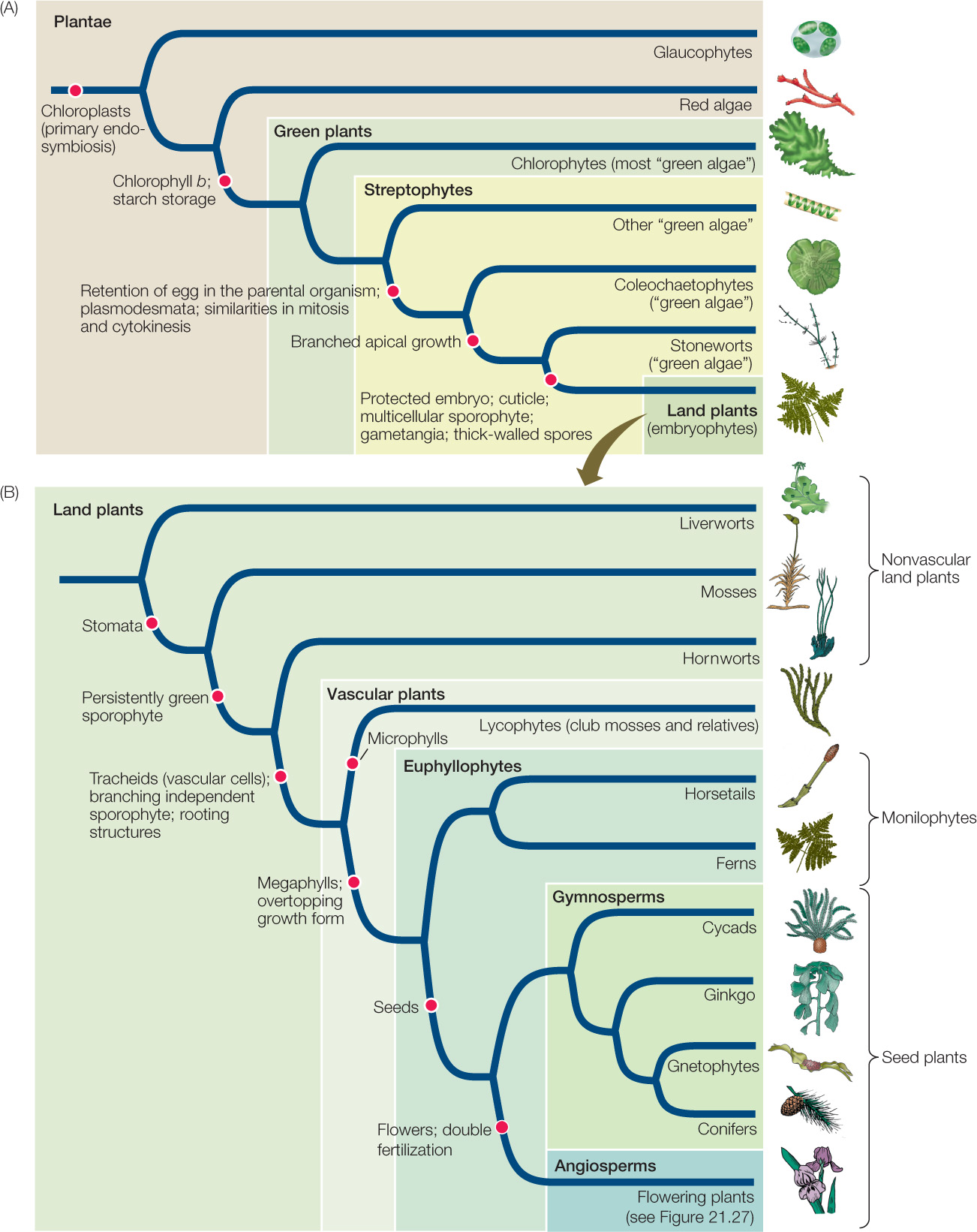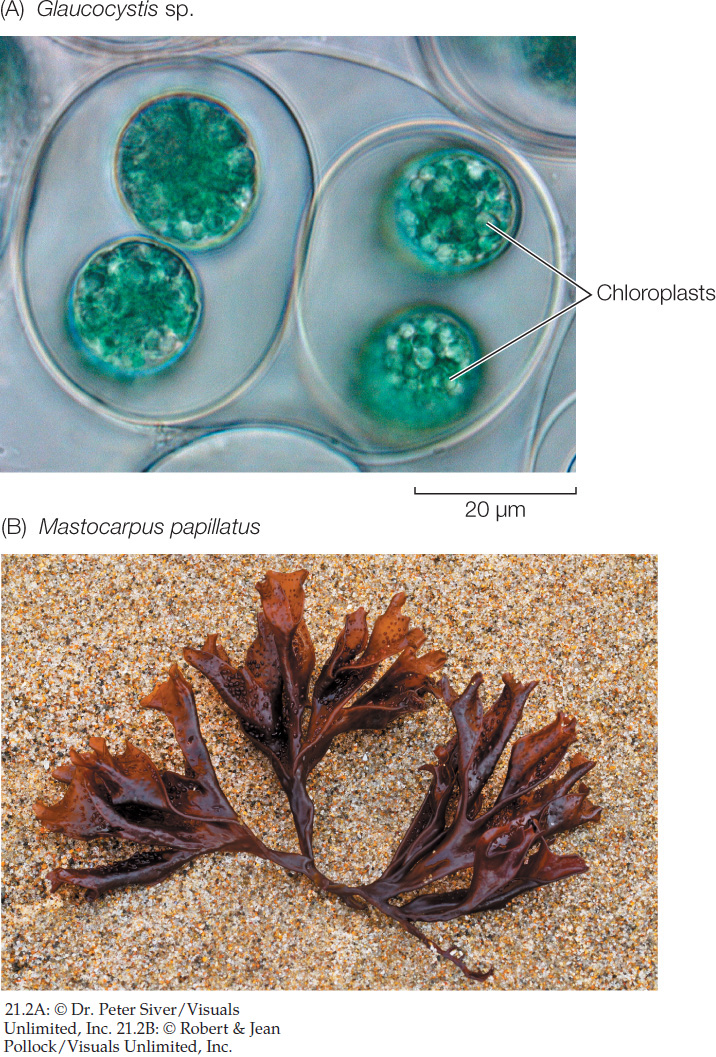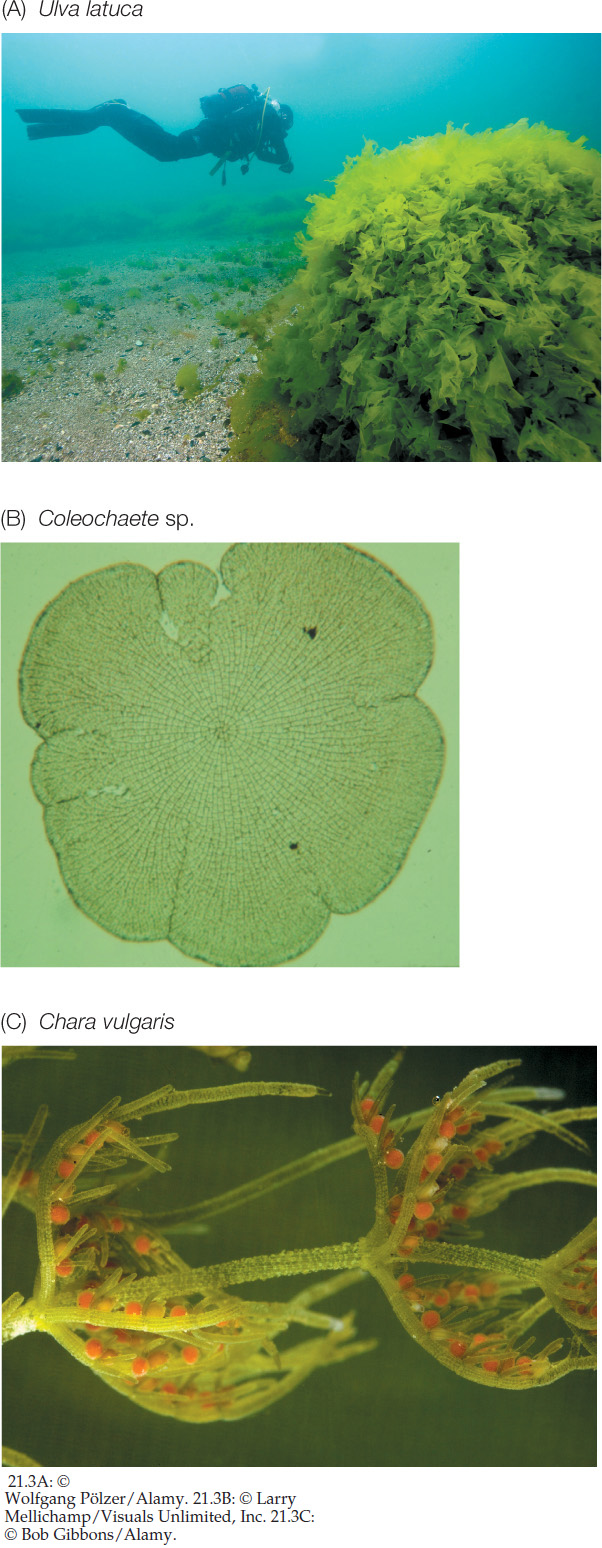Concept 21.1: Primary Endosymbiosis Produced the First Photosynthetic Eukaryotes
More than a billion years ago, when a cyanobacterium was first engulfed by an early eukaryote, the history of life was altered radically. The chloroplasts that resulted from primary endosymbiosis of this cyanobacterium (see Figure 20.2) were obviously important for the evolution of plants and other photosynthetic eukaryotes, but they were also critical to the evolution of all life on land. Until photosynthetic plants were able to move onto land, there was very little on land to support multicellular animals or fungi, and almost all life was restricted to the oceans and fresh waters.
Primary endosymbiosis is a shared derived trait—a synapomorphy—of the group known as Plantae (FIGURE 21.1). Although Plantae is Latin for “plants,” in everyday language—and throughout this book—the unmodified common name “plants” is usually used to refer only to the land plants. However, the first several clades to branch off the tree of life after primary endosymbiosis are all aquatic. Most aquatic photosynthetic eukaryotes (other than those secondarily derived from land plants) are known by the common name algae. This name, however, is just a convenient way to refer to all such groups, which are not all closely related.

Several distinct clades of algae were among the first photosynthetic eukaryotes
The ancestor of Plantae was unicellular and may have been similar in general form to the modern glaucophytes (FIGURE 21.2A). These microscopic freshwater algae are thought to be the sister group to the rest of Plantae (see Figure 21.1A). The chloroplast of glaucophytes is unique in containing a small amount of peptidoglycan between its inner and outer membranes—the same arrangement found in cyanobacteria. Peptidoglycan has been lost from the remaining photosynthetic eukaryotes.

In contrast to the glaucophytes, almost all red algae are multicellular (FIGURE 21.2B). Their characteristic color is a result of the accessory photosynthetic pigment phycoerythrin, which is found in relatively large amounts in the chloroplasts of many red algae. In addition to phycoerythrin, red algal chloroplasts contain chlorophyll a as well as several other accessory pigments.
The red algae include species that grow in the shallowest tide pools as well as the photosynthesizers found deepest in the ocean (as deep as 260 meters if nutrient conditions are right and the water is clear enough to permit light to penetrate). A few red algae inhabit fresh water. Most grow attached to a substrate by a structure known as a holdfast.
Despite their name, red algae don’t always appear red in color. The ratio of two pigments—phycoerythrin (red) and chlorophyll a (green)—depends largely on the intensity of light that reaches the alga. In deep water, where light is dim, algae accumulate large amounts of phycoerythrin (which absorbs light at short wavelengths) and appear red. But many species growing near the surface contain a higher concentration of chlorophyll a and thus appear bright green.
The remaining algal groups in Plantae are the various “green algae.” Like land plants, the green algae contain both chlorophylls a and b and store their reserve of photosynthetic products as starch in chloroplasts. All the groups that share these features are commonly called green plants because both of their photosynthetic pigments are green.
Three important clades of green algae are the chlorophytes, coleochaetophytes, and stoneworts (FIGURE 21.3). The chlorophytes are the sister group of all the other green plants, which are collectively called streptophytes. Among the streptophytes, the coleochaetophytes and stoneworts retain their eggs in the parental organism, as do land plants. They also share other cellular features with the land plants (see Figure 21.1A). Of these two groups, the stoneworts are thought to be the closest relatives of the land plants, based largely on similarities of their genes. The stoneworts also exhibit the branched apical growth that is typical of many land plants (see Figure 21.3C).


Go to MEDIA CLIP 21.1 Reproductive Structures of Chara
PoL2e.com/mc21.1
There are ten major groups of land plants
One of the key synapomorphies of the land plants is development from an embryo that is protected by tissues of the parent plant. For this reason, land plants are sometimes called embryophytes (phyton, “plant”). The green plants, the streptophytes, and the land plants each have been called “the plant kingdom” by different authorities, and others take an even broader view to include red algae and glaucophytes as “plants.” To avoid confusion in this chapter, we will use modifying terms (“land plants” or “green plants,” for example) to refer to the various clades of Plantae shown in Figure 21.1.
The land plants that exist today fall naturally into ten major clades (TABLE 21.1). Members of seven of those clades possess well-developed vascular systems that transport materials throughout the plant body. We call these seven groups, collectively, the vascular plants, or tracheophytes, because they all possess fluid-conducting cells called tracheids. The remaining three clades (liverworts, hornworts, and mosses) lack tracheids and are referred to collectively as nonvascular land plants. Note, however, that the three groups of nonvascular land plants do not form a clade (unlike the vascular plants, which are a clade).

CHECKpoint CONCEPT 21.1
- Explain the different possible uses of the term “plant.”
- What are some of the key differences between glaucophytes, red algae, and the various clades of green algae?
- What evidence supports the phylogenetic relationship between land plants and green algae? Why doesn’t the name “algae” designate a formal taxonomic group?
The green algal ancestors of the land plants lived at the margins of ponds or marshes, ringing them with a mat of dense green. It was from such a marginal habitat, which was sometimes wet and sometimes dry, that early plants made the transition onto land.
422
423